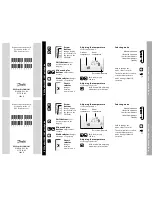
Plumbing Guidelines
General
In order for your sprayer to function properly, it must be
correctly plumbed.
The system diagrams (on pages 12 and
14)
show the plumbing configuration that works best with
the MT-3405D Sprayer Controller. This section will explain
the purpose of each component, list some problems it can
cause and recommend some possible solutions to those
problems.
A word about pressure drops: All hose, valves and fittings
(especially elbows) cause undesirable pressure losses. Keep
hoses as large as practical. Don’t use longer hoses than
necessary. Avoid bends whenever possible. Use as few
fittings as possible. Use full port valves or the next larger size
valve. Long hoses should be supported to avoid sagging and
kinking. Many spray tip manufacturers have charts showing
pressure drop for various fittings and hose sizes.
Now let’s break the system diagram into five sections and
cover each one separately. The five sections are the pump
inlet line, the agitation line, the flowmeter (boom) line, the
servo line and the pump itself.
PUMP INLET
The hose connecting the tank to the pump should be at
least as large as the pump inlet port. In most cases 11/4” is a
good size. The valve in this line is for complete tank shut-off
only and should always be fully open during operation. If
this hose is too small or the valve is partially closed, you may
not be able to reach your high end goals and pump damage
could occur.
AGITATION
The size of the agitation line is dependent upon the amount
of agitation required which is determined by the size of the
tank and the type of chemical being used. In most cases a 1”
hose is large enough.
SERVO
On the system diagram, the hose between tee “B” and the
servo can usually be 3/4” but 1” will also work. The hose
between the servo and tee “C” should be at least as large as
the servo. If these lines are too small, you may experience
little or no pressure adjustment.
FLOWMETER
The line feeding the flowmeter and the boom shut-off valves
should be at least as large as the flowmeter. The size of
lines going from the shut-off valves to each boom section
depends on the flow rate of each boom.
45
PUMP
The pump must have enough capacity to satisfy the agitation,
servo and flowmeter sections of the plumbing. To determine
if your pump is large enough you must add up the gallons
per minute of all three sections. The following example will
take you through the steps involved.
EXAMPLE
Let’s say our example sprayer has a 300-gallon tank
with a Spraying Systems 6290 SC-8 Jet Agitator. The
agitator uses 10.2 GPM at 40 PSI.
The sprayer has a 40’, three-section boom. Each
section is 160” with four tips at 40” for a total of 12
tips. We plan to put on a 25 GPA at 5 MPH and in
some areas of the fields we may want to use the
Delta feature and increase our rate to 30 GPA and in
other areas decrease to 15 GPA. After checking the
tip charts we find that a TK-5 Floodjet has a range of
14.9 to 30 GPA at 5 MPH. According to the charts, to
get 30 GPA at 5 MPH with a TK-5, the pressure must
be 40 PSI. At 40 PSI a TK-5 will spray 1.0 GPM. So, 12
tips at 1.0 GPM each is a total of 12 GPM.
There is about 5 GPM “blow by” with the servo closed at
40 PSI. (In bypass, servo closed sends max flow to the
booms.)
Now let’s add everything together.
Agitation 10.2
Spray tips
12.0
Servo
5.0
27.2
Total
GPM
The above addition shows that the system needs
27.2 GPM at 40 PSI. If we add a 10% margin (27.2 x
.1 = 2.72 added to 27.2 = 29.92), we have about 30
GPM. To be sure we have enough volume, the pump
should be able to deliver 30 GPM or more at 40 PSI.
Summary of Contents for DUAL CONTROL MT-3405D
Page 1: ...REFERENCE MANUAL DUAL CONTROL AUTOMATIC RATE CONTROLLER MT 3405D ...
Page 47: ...Appendices 47 ...
Page 82: ...82 NOTES ...
Page 83: ......
















































